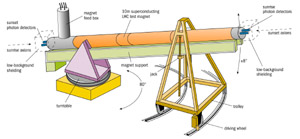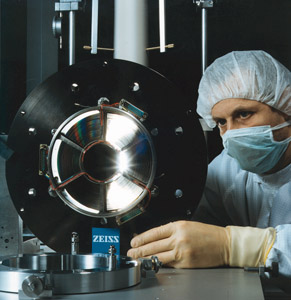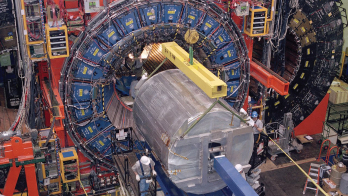
The CERN Solar Axion Telescope, CAST, aims to shed light on a 30-year-old riddle of particle physics by detecting axions originating from the 15 million degree plasma in the Sun’s core. Axions were proposed as an extension to the Standard Model of particle physics to explain why CP violation – a phenomenon linked to the dominance of matter over antimatter in the universe – is observed in weak but not strong interactions – the so-called strong-CP problem.
One of the most striking consequences of this is the neutron electric dipole moment, which, due to a CP-violating term in the standard equations, is calculated to be ten orders of magnitude larger than its measured upper limit. This can be overcome by introducing a further symmetry, the spontaneous breaking of which yields the axion – a neutral pion-like particle that interacts very feebly. Owing to their potential abundance in the early universe, axions are also leading candidates for the invisible dark matter of the universe.
Searches for solar axions began a decade ago when the US Brookhaven Laboratory first pointed an axion telescope at the Sun – a highly useful source of weakly interacting particles for fundamental research, as the solar neutrino anomaly amply demonstrates. Axions would be produced in the Sun through the scattering of photons from electric charges – the Primakoff effect – and their numbers could equal those of solar neutrinos. The idea behind the Brookhaven experiment, first proposed by Pierre Sikivie, was to put the Primakoff effect to work in reverse, using a magnetic field to catalyse the conversion of solar axions back into X-ray photons of a few kilo-electronvolts.
The Brookhaven telescope was later joined by another in Tokyo, while other experiments continued the search in different ways. Experiments at Brookhaven, the Lawrence Livermore Laboratory and Kyoto, for example, search for relic axions from the early universe. CERN’s NOMAD experiment joined the hunt, looking for axion production in a neutrino beam. Searches based on axion Bragg scattering have been performed by the SOLAX collaboration using a 1 kg single crystal of germanium in an underground laboratory in Argentina, while optical detection techniques are employed by Italy’s INFN experiment, PVLAS.

This list is not complete, but, taken together, earlier experiments have scanned the kinetic energy range from 10-11 eV up to 1011 eV, so far without success. CAST, however, could make a difference because of the length and strength of the magnetic field that it will have available by using a prototype magnet for CERN’s LHC collider.
The conversion efficiency for axions increases as the square of the product of the transverse magnetic field component and its length. This makes a 9 tesla, 10 m LHC prototype dipole magnet with straight beam pipes ideal for the task, giving a conversion efficiency exceeding that of the two earlier telescopes by a factor of almost 100.
CAST’s LHC magnet will be mounted on a moving platform with X-ray detectors on either end, allowing it to observe the Sun for half an hour at sunrise and half an hour at sunset. The rest of the day will be devoted to background measurements and, through the Earth’s motion, observations of a large portion of the sky. CAST’s X-ray detectors are under development, with the collaboration looking at gas-filled and solid-state options. A chamber using the “micromegas” principle has been tested.
The aperture of the LHC magnet’s beam pipes is around five times the predicted solar axion source size, so its X-ray detectors must be correspondingly large, implying a high level of noise. To overcome this problem, the CAST collaboration is considering using X-ray lenses to focus the converted X-rays emerging parallel from the 50 mm magnet aperture to a submillimetre spot. This will bring a vast signal-to-noise improvement over the original CAST proposal and the earlier solar axion telescopes. An option to recover mirrors constructed for the German orbiting X-ray telescope ABRIXAS is being pursued.
CAST is a new departure for CERN, relying not on the lab’s expertise in accelerators but on its know-how in X-ray detection, magnets and cryogenics. With a discovery potential for axions extending beyond that dictated by astrophysical considerations, the experiment leaves room for surprises and could open up a new field of terrestrial axion astrophysics. CAST should be ready to begin its search this autumn.
Further reading
G G Raffelt 1996 Stars as Laboratories for
Fundamental Physics (University of Chicago Press, Chicago & London).








